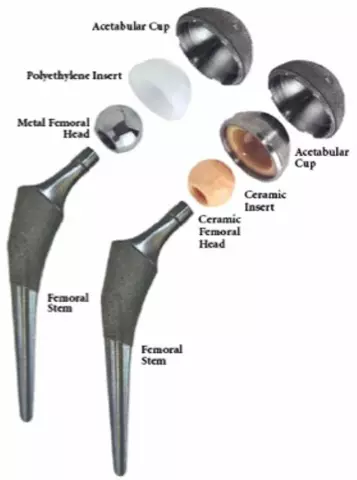- Author Curtis Blomfield [email protected].
- Public 2023-12-16 20:44.
- Last modified 2025-01-23 17:01.
Hip replacement (endoprosthetics) is an operation that results in the complete replacement of diseased cartilage and bones with artificial prostheses, consisting of a concave bowl and a spherical head. The main goal of this surgical intervention is to reduce pain caused by various diseases of the joint.
When is arthroplasty done?

Hip replacement is performed for the following conditions:
- Arthrosis.
- Fractured femoral neck.
- Polyarthritis.
- Violation of the process of blood supply to the hip joint.
- Necrosis of the femoral head, which may be caused by certain medications or certain surgical procedures (such as kidney transplants).
However, hip replacement is not performed immediately after diagnosis. Surgical intervention is performed only when the pain in the joints becomes permanent, contributes to the deterioration of the simplest functions (walking, climbing stairs, etc.) and is not relieved with the strongest painkillers.
Are there any risks in this operation?

As with any other surgical intervention, complications are possible with arthroplasty:
- Penetration of infection into the surgical wound or into the place where an artificial prosthesis is installed. This can manifest as redness, swelling, and pain at the surgical site. To prevent such complications, antibiotics are prescribed.
- Looseness of the joint, which may be accompanied by pain in it. The elimination of this complication is only surgical.
- Hip replacement can lead to thrombosis. With a decrease in movement on the operated leg, stagnation of blood in the veins may develop. To prevent this, the patient is not allowed to lie down for a long time and anticoagulants are prescribed.
- Ossification is the impregnation of the tissues surrounding the joint with calcium s alts. This factor can lead to limited joint mobility.
- Displacement of the prosthesis. May occur during certain movements. To avoid this complication, patients should not cross their legs or bend them at the hip joints by more than 80 degrees.
- Change in the length of the operated leg. going onthis complication as a result of relaxation of the muscles surrounding the joint. This problem is solved by performing special physical exercises.
Hip replacement surgery

In general, arthroplasty is carried out according to the general scheme:
- An incision is made on the side or front of the thigh.
- Cartilage or diseased bone is removed.
- Implantation of socket sleeve in progress.
- The hip joint is being replaced with an artificial prosthesis that is attached to the hip bone.
- The incision is sutured.
Hip replacement, which is priced according to the material of the prosthesis, is performed under general or spinal anesthesia.






